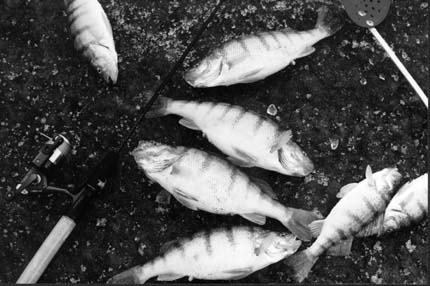 Yellow perch are an extremely adaptable fish that can thrive in a great variety of habitats. Their native range is from the Lesser Slave Lake and the Hudson Bay region in Canada southward through the Great Lakes to Kansas, Iowa, Illinois, Indiana, Pennsylvania and as far south as South Carolina.
Yellow perch are an extremely adaptable fish that can thrive in a great variety of habitats. Their native range is from the Lesser Slave Lake and the Hudson Bay region in Canada southward through the Great Lakes to Kansas, Iowa, Illinois, Indiana, Pennsylvania and as far south as South Carolina.
Perch were first introduced to Utah in 1890 when someone got the wise idea to put them in the Weber River. Shortly thereafter perch were planted into numerous waters throughout the state.
Perch are now found in Bear Lake, Newton, Hyrum, Rockport, Echo, Pineview, Deer Creek, Utah Lake, Yuba, Willard Bay, DMAD, Gunnison Bend and Fish Lake.
Probably the worst two places perch have shown up in the past were Strawberry and Scofield reservoirs. Eventually both reservoirs were treated to remove them and there are no perch in either reservoir now.
In Utah most perch are caught through the ice, in the winter. Almost no one fishes for perch during the rest of the year, even though they are readily caught year round.
Perch are generally easy to catch and will readily take a wide variety of baits and lures. They feed all day long but are especially active in the morning and evening. Perch generally don't feed much or at all at night.
I proved this at Pineview several winters ago. I took a group of Boy Scouts on a campout. By the time we got camp set up and dinner cooked it was well after dark. After dinner we decided to try a little fishing. We lit lanterns and slid out onto the ice. We fished and fished without a single bite. I couldn't figure what we were doing wrong. Finally after some friendly kidding from the boys we gave up for the night without a single fish. The next morning we fished the same area, same baits, same everything and caught fish after fish. Perch just don't feed at night.
Perch can be great fun to catch or a tremendous nuisance. Everyone likes to catch big perch and no one likes to catch little ones. Perch size is directly related to spawning success, food supply and predation. Bass, walleye, tiger muskies, northern pike and even big trout love to eat perch.
A well established predator will keep perch numbers in check and perch size will increase. When few predators are present perch will over-populate, eat all the available food and stunt.
Perch belong to the Percidae family of fish and are closely related to walleye and sauger. All of the species of this family are spiny-rayed and have two well separated dorsal fins. The first fin (closest to the head) has the most spines.
When threatened the perch raises these fins as a defense against being eaten. The spines on the fins are extremely sharp and can inflict a painful wound.
Perch spawn in the spring when the water temperature is between 44 and 55 degrees. They generally spawn at night. Depending on its size, a perch will spawn between 4,000 and 40,000 eggs.
Perch do not build nests and the eggs are generally laid over aquatic vegetation. The strands of eggs are sticky and adhere to the vegetation. The eggs hatch in from 8 to 10 days. Perch are not good parents and not only don't care for their young, but will readily eat them if possible.
Yellow perch like clear, cold water in lakes and large ponds but will also inhabit slower moving parts of large rivers. Perch do not do well in small ponds or small streams.
They generally school by age class and the schools may be large, especially for the younger fish.
Perch like to hang out around weed beds but will move into deep water as the shallow water warms. Perch will suspend in deep water but are generally found within a foot or two of the bottom.
Perch are carnivorous and will eat just about any kind of creature they can get their mouth around. They will eat other fish, crawfish, snails, insects, worms, fresh water shrimp and fish meat.
Perch meat or eyeballs are two of the best baits but perch will also readily take mealworms, wax worms, small pieces of nightcrawlers, oysters, anchovies and other fish meat. A flashy attractor six to 10 inches above the bait will increase the catch rate.
The Utah state record perch weighed in at two pounds and 11 ounces. The largest perch ever caught came out of the Delaware River in 1865. It weighed four pounds three and a half ounces. Most perch never reach 12 inches in length and a pound in weight.
Perch grow slowly but can live for nine or 10 years.
